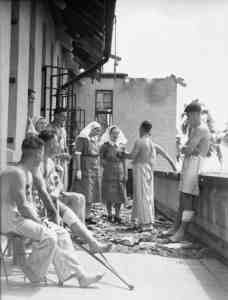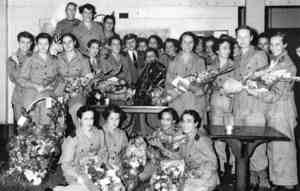With the entry of Japan into World War 2 following the bombing of Pearl Harbour in 1941, conditions in military hospitals in South-East Asia changed dramatically. Already stretched beyond capacity, the now torrential flow of casualties threatened to become overwhelming. As Japanese soldiers advanced towards Singapore in February 1942, the casualty rate increased to desperate levels.

Like to copy this image? Please click here first
AWM 012451 AIF nurses and patients at the military hospital in Singapore after a bombing raid in early January 1942.
At this time, there were more than 100 Australian military nurses from three military medical units - 2nd/4th Casualty Clearing Station, 2nd/10th and 2nd/13th Australian General Hospitals - which formed part of the 8th Australian Division, stationed in Singapore. On the 6th of February 1942, the order came for all nurses to evacuate. For the nurses it was a heartbreaking decision as only a handful of soldiers were fit for the trauma of evacuation. In the face of the duty they held so dear, rose the agonising reality of abandoning the vast majority of wounded to an unknown and possibly merciless, enemy.
Three ships were used in the evacuation, all hastily refitted as hospital ships, yet ill-designed for the purpose. As fate would decree, the destiny of the nurses on each of the three ships was wildly different. The first ship to leave, the Wah Sui, sailed on the 10th of February. Although bombed during the embarkation process in Singapore harbour, the vessel escaped serious damage and reached Batavia (now Jakarta) relatively unscathed. Within a few weeks, the nurses were safely home in Australia.
The second ship, the Empire Star, left on the 11th of February. The Empire Starwas a cargo ship designed to carry 24 passengers. Dire necessity dictated that more than 2,000 people were crammed into its holds, berths and massed across its decks. Among the evacuees were Australian, British and Indian nurses, British troops and civilian women and children. During its passage, the ship was heavily bombarded by 92 Japanese bombers. Despite massive damage and huge losses to life, the Empire Star somehow limped to safety in Batavia. Vital repairs were carried out and the ship, incredibly, eventually reached its destination in Australia without further incident.
The last ship to leave Singapore Harbour was the Vyner Brook. She sailed on the 12th of February, vastly overcrowded and with little in the way of effective defences. She carried 65 Australian nurses led by the redoubtable matrons Paschke and Drummond. The nurses were organised into teams with responsibility for the various areas of the ship. Should the ship come under fire, the nurses were instructed that their priority would rest with tending the wounded. Should the order be given to abandon ship, the nurses knew they would be the last to leave.
The Vyner Brook was attacked on the 14th of February in the Bangka Strait and sank within half an hour. While all the nurses survived the bombing, many drowned or were killed by the returning Japanese planes which raked those survivors struggling in the water with deadly machine-gun fire. The 53 remaining nurses staggered ashore in various stages of exhaustion, having spent anywhere from eight to 65 hours in the water.
One group of survivors was washed ashore on Bangka Island. It was a motley group, comprising nurses, soldiers and civilian men and women. Finding themselves in a desperate situation, they surrendered to Japanese soldiers on the 16th of February. The men in the group were immediately led to a beach behind a bluff. The Japanese soldiers returned alone, cleaning their rifles and bayonets in front of the horrified women. The nurses were then ordered to walk into the sea, where they were machine-gunned. Only one nurse survived, Sister Vivian Bullwinkel. Although wounded, she feigned death until she felt certain the Japanese had left the beach. As she wandered ashore, dazed, the full enormity of the horror she had witnessed dawned on her. She was alone, in pain, desperately afraid, but she was alive.
Driven by a desperate need to survive, Vivian hid in the undergrowth, staying out of sight of the Japanese. She soon discovered that she was not alone, happening upon a wounded British soldier, helpless and in great pain. She nursed him as best she could, but soon faced the gnawing realisation that he would not survive without urgent medical attention that she, alone, could not provide. The decision was a dreadful one. She knew she risked certain death for both of them, but felt that the slim chance of survival that surrender to the Japanese presented was infinitely preferable to the agony of watching the soldier die a lingering and painful death.
Carefully concealing evidence of the wound in her side that she carried from the massacre on the beach, Vivian and the soldier surrendered to the Japanese on the 28th of February. For her, it proved to be the right decision as, although incarcerated in Japanese prisoner-of-war camps on Bangka Island and Java over the next three and a half years, she lived to tell the tale. She joined the ranks of other nurses who had survived bombings and sinkings and now faced a gruelling and uncertain future. Eight of these nurses died in the camps during the final seven months of the war. All died of beriberi and some were also suffering from malaria. Of the original 65 dedicated and courageous women who volunteered their lives to save those of others, only 25 survived to return to Australia.

Like to copy this image? Please click here first
AWM P01701.003 October 1945. Australian Army nurses, who were former prisoners of war aboard the hospital ship Manunda on its arrival at Fremantle, WA. Most of the nurses were staff members of the 2/10th and 2/13th Australian General Hospital and the 2/4th Casualty Clearing Station. Many hold bouquets of flowers that had been sent by their families.
On the 2nd of March 1993, 51 years after the nurses faced that agonising evacuation from Singapore, a group of survivors attended the dedication of a memorial in honour of those 65 nurses who were aboard the Vyner Brook on that fateful voyage. A stone from one of the prisoner-of-war camps is embedded in the memorial, which is erected away from the camps themselves, close to the massacre site at Radji Beach.
The return to Bangka Island was a defining experience for the seven nurse survivors in the party. Among their number was Vivian Bullwinkel, for whom the emotion must have been indescribable. It was a quiet, dignified ceremony, marked by the individual contributions of each of these women, some reading from the Bible, others offering prayers from the heart. Accompanying the survivors from the Vyner Brook were nurses from the Empire Star, reliving their own experience of fear and wartime trauma.
As a fitting tribute to wartime nursing and an empathetic salute to their comrades in uniform, seven serving Royal Australian Army Nursing Corps members accompanied the survivors on what, for many, may have been their last journey to a place of tragedy. Many relatives of those who perished also made the pilgrimage as a means of at last farewelling their loved ones. For one woman, a girl of nine at the time of the fall of Singapore, it was a particularly cathartic experience. One of the nurses shot on the beach was a favourite aunt, still remembered with enormous affection and great sadness.
From the windswept reaches of Radji Beach, the party travelled to Jakarta to pay tribute to the eight nurses who died in the prisoner-of-war camps and now lie in the Commonwealth War Graves Commission Cemetery. Those nurses who were lost at sea and those massacred at Bangka Island, commemorated by name at Kranji War Cemetery in Singapore, were likewise honoured and remembered by the survivors and relatives who visited the cemetery.
I was deeply honoured to be selected to accompany the nurses and relatives on this their pilgrimage. I listened, inspired, profoundly moved and in a sense, horrified, at the pure veracity of what they described. These nurses had forged deep and binding bonds, strengthened in adversity, the true depth of which I could only surmise. I felt them to be immensely generous in sharing their stories with us. The agony of reliving such experiences is something we will never truly understand.
They described in particular the dire conditions they experienced in Singapore when they attempted to nurse more than 1000 wounded soldiers in a facility designed for 200. They evoked images of nursing at night with no light, but vast numbers of critical patients whose needs remained desperate regardless of time. They described nursing dying and severely wounded men with almost no supplies, lacking even the barest of basics. They described also the terrible trauma of having to leave the wounded behind in the face of the oncoming enemy. This they saw as the ultimate neglect of their deepest duty, their duty of care for the patient.
With little bitterness, they described their experiences in the camps. It was with commensurate horror, but little surprise that we heard of the now-infamous deprivations of the camps. Their will to live, their incredible ability to survive through wit and imagination was completely overwhelming. When I asked one of the nurses where this incredible ability to survive came from, she shrugged her shoulders and simply replied, ‘You just do it’.
Many of their recollections were characterised by humour and joy. Some of the nurses joined the camp choir and brought relief from the daily grind through rehearsals and concerts. The same tremendous feeling of comradeship pervaded these stories that characterised the horrendous recollections of survivors of the Burma-Thai Railway: ‘If you didn’t have a mate, you were gone’. They were desperate to survive, but to survive together, and the death of any of their number was such a devastating blow that morale would be low for weeks.
The stories of their incredible courage reinforce in me the belief that my service as a military nurse should embody my tribute to their tremendous dedication and sacrifice. They went to war in such uncertain times. The only certainty lay in doing their duty. For military nurses serving today, the operational experience is so vastly different - we leave Australia with an idea of when we will return. Yet our common bond, undiminished by the years, lies in the utter strength of their commitment and is a value dearly cherished by nurses today.





